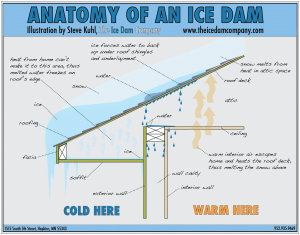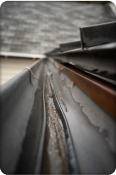Heated Gutters in North Bethesda and Gaithersburg, MD
Using Heat Tape To Create A Heated Gutter
A heated gutter system consists of a gutter with self-regulating heat tape threaded through the gutters and downspouts beneath a gutter guard. This heat tape keeps the gutter warm during winter, helping to prevent issues that can arise from snow and ice accumulation. If you live in the Bethesda-Gaithersburg, MD, area, call (240)-202-2242 to learn more!
Talk to us about Heated Gutters Today!
Why Heated Gutters?
As a homeowner living in a colder climate, dealing with snow and ice accumulation on your roof can be a constant source of worry, especially when it comes to the risk of ice dams forming and causing leaks. The water damage that follows can quickly turn into a major headache, threatening both your peace of mind and the well-being of your home.
During harsh winters, homeowners often face significant damage caused by ice damming, which can result in costly repairs. The accumulation of large icicles hanging from the roof’s edge above walkways and driveways poses a safety hazard throughout the winter months.
In severe situations, the combined weight of snow and ice may even cause gutters to detach from the house, leading to cracks or complete collapse. To help prevent ice dams and offer greater peace of mind, many homeowners choose to install heat tape in their gutters. This heated cable is designed to melt snow and ice effectively without harming the home.
What About Heated Tape on the Roof?
Unlike traditional roof heat cables that are placed on top of the roof and run along its edge, our approach involves installing heated gutter cables—sometimes referred to as heat tape—inside the gutters, just beneath a gutter guard system, as well as inside the downspouts. This setup, which combines heated gutters with heated gutter guards, effectively addresses and prevents many of the common issues associated with standard roof heat tape or heat cable installations.
The real value of installing heat tape depends entirely on whether it is done properly. Many companies use different installation methods, with the most common being a zigzag pattern that forms triangles across the first three feet of the roof, after which the cable continues inside the gutter and down the downspout. While this method may melt snow and ice on the roof itself, it does not actually stop ice dams from forming in or on your gutters. As a result, ice can still accumulate and clog the gutters, restricting water flow and potentially causing further problems.
Moreover, this popular installation method has been shown to cause more long-term damage to the roof than not using any cable at all, and it may even void your roof’s warranty.
Heat Tape works better inside a Gutter System
We use Weather-Ready heat tape, installing it exclusively inside the gutters and downspouts to ensure that your shingles remain unaffected and the heat tape stays protected while only the gutters are heated. This approach is not only highly effective but also visually appealing. When combined with a gutter guard, the heat generated by the tape is trapped inside, keeping the entire gutter system warm. As a result, when snow on the roof begins to melt, it encounters both a warm gutter guard and a warm gutter, which prevents ice and snow from accumulating in your gutters. This means your gutters only have to handle water, not ice. For the best performance, it’s important to turn on the heat cable just before snowfall. If you’re interested, you can learn more about how heat cables work.
Heated cable for your gutters is essential in regions that experience extremely harsh winters and heavy snowfall, as it helps prevent the formation of ice dams and stops water from entering your home.
Snow Guards
Snow Guards, which should not be mistaken for Gutter Guards, serve a valuable purpose for roofs in areas that experience heavy snowfall. They are specifically designed to keep snow and ice from sliding off the roof all at once, helping to prevent dangerous avalanches that could potentially damage landscaping or pose a risk to people walking underneath.
Ice Dams
Ice dams typically form when a roof has uneven or insufficient insulation, or when other factors cause temperature fluctuations that allow snow to melt and flow down the roof. As this melted snow reaches the colder eaves, it refreezes, causing ice to accumulate along the roof’s edge or in the gutters. This buildup traps more ice and water above it, which can then back up under the shingles. As a result, water may seep into your attic, ceilings, and interior walls, potentially leading to costly repairs and the need for mold remediation.
What Causes Ice Damming?
There are a variety of reasons behind this problem. The most common reasons for ice damming are:

The pitch of a roof plays a significant role in how quickly ice damming can develop, with lower-pitched roofs being more susceptible to this issue. Many homeowners notice ice damming near bathroom vents and chimneys, as these areas often experience temperature fluctuations.
Traditional roof heat cables are typically installed on top of the roof, leaving the cable exposed and sometimes allowing ice to form above the heat tape. This can shift the problem higher up the roof, away from the protective benefits of the roof’s drip edge and ice/water shield. When the heat tape melts snow, the resulting water can flow downward and refreeze as it reaches the colder gutters, which are exposed to the surrounding cold air. In contrast, a heated gutter system uses gutter heat tape to warm the entire gutter, preventing this refreezing and eliminating the issue.
Without a heated gutter, ice often accumulates in the gutters first, which leads many people to wonder if gutters themselves are the cause of ice dams.
Why Gutter Guards are an important part of a Heated Gutter System?
Gutter guards are intended to prevent leaves and debris from clogging your gutters, but they also provide additional benefits. They reinforce the gutter structure, offer protection for heat cables, and help keep snow out, which allows it to melt more quickly. When heat tape is installed inside the gutter, it warms the entire system, melting snow as it lands and reducing the risk of ice buildup that could cause water to enter your home or create large icicles hanging from the roof or gutters. If the heat cable is left exposed to the elements, it can become damaged, and leaves and debris are more likely to get caught on it.
Are Heated Gutters Safe? What about potential fire hazards?
The Nuheat Weather-Ready heat tape installed by The Brothers that just do Gutters is constructed with a UV-resistant polyolefin outer jacket, a tinned copper braided layer, and a fire-resistant conductive core. Nuheat industries mandates that each heating cable circuit be equipped with ground-fault protection to further minimize the risk of fire from continuous electrical arcing, which can occur due to improper installation or damage to the cable. In certain situations, a licensed electrician may be required to complete the final connection. Placing the heat cable directly on the roof’s surface poses a potential fire hazard, as improper installation or damage to the cable can increase the risk of electrical faults and fire.
How much electricity does it use?
Your actual electrical usage will depend on the length of the cable run. The Nuheat Weather-Ready heat tape is designed to self-regulate its power output based on changes in ambient conditions. When the temperature drops and there is ice or snowfall, the power output increases to provide more heat. As the temperature of the water and ice rises, the heat tape automatically reduces its wattage and emits less heat. For additional information, you can refer to our page on the cost of heated gutter systems.
Heated Gutter Demonstration
We put together a video demonstration of how a heated gutter system works. We placed piles of snow on top of the gutters so that viewers can see them melt through a time-lapse video.
To achieve the best results, you should turn on your heat cable before a snowstorm begins. This allows the heated gutter to melt snowflakes as soon as they land. If ice or snow has already accumulated, the cable will still melt it, but the process will require more time and energy.
Note: For this simulation, we started with a mound of snow already on the gutter; during an actual snowstorm the flakes will melt as they land on the heated gutter. Be sure to visit our many blogs on this topic.
Installing Heat Tape – Using Heat Tape To Create A Heated Gutter
When installing heat tape, it is important to take several factors into account. Spacing is a key consideration, which will depend on the pitch of your roof and the length of your soffit. The heated cable is typically installed within your gutters and downspouts, and the most effective approach is to place the heat cable beneath a gutter guard. Using a gutter guard not only protects the cable but also helps to trap heat, making the entire system work more efficiently and reducing the risk of ice dams.
To supply power to the heat tape, you can use a premade length of heat tape or a GFCI plug-in cord set connected to an existing outdoor outlet, which avoids the need for hardwiring. However, if you do not have an outdoor outlet available or if your setup presents unique challenges, it may be advisable to consult an electrician to complete the power connection.
Table of Contents
Why Heated Gutters?
What about Heat Tape on the Roof?
Heat Tape works better inside a Gutter System
Snow Guards
Ice Dams
What Causes Ice Damming?
Why Gutter Guards are an important part of a Heated Gutter System?
Are Heated Gutters Safe? What about potential fire hazards?
How much electricity does it use?
Heated Gutter Demonstration
Installing Heat Tape
Talk to us about Heated Gutters Today!
Design the Perfect Gutter System
Complete the form today to book your free gutter estimate! Our solutionist will guide you through your options and craft a custom system for your house.



